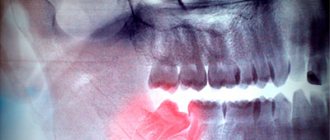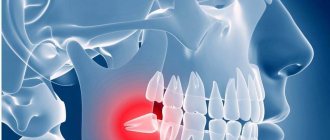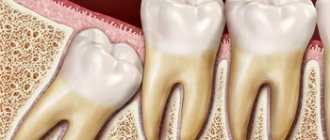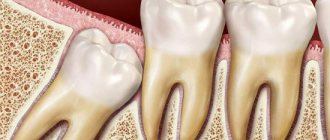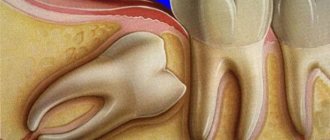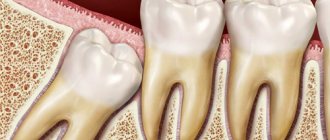For most people, the growth of wisdom teeth is accompanied not only by gum cutting and discomfort, but also by quite severe pain that makes it difficult to eat, concentrate on any task, and even sleep.
If the wisdom tooth grows and does not cause significant discomfort, no medical action may be taken. As a rule, the discomfort goes away after 1-2 weeks, but in order to avoid the manifestation of other problems, it is worth undergoing an examination at a dental clinic. However, if the gums from the wisdom tooth become inflamed, the local and general temperature rises, and specific aching pain is felt, immediately contact your dentist, he will conduct an examination and take the necessary measures to eliminate the problem.
Symptoms of wisdom tooth growth
During the period when a wisdom tooth comes in, a number of specific symptoms can be observed, by which it can be determined that the discomfort comes specifically from the eights:
- Discomfortable sensations in the tooth area, in some cases – gum thickening;
- Feeling of swelling in the gums;
- Increased local temperature, painful swelling;
- In the molar area, soft tissues (gums) become inflamed;
- Difficulty opening the mouth and swallowing. When opened wide, a sharp, aching pain is felt;
- There is a desire to chew any hard food or objects. After such chewing, the pain increases significantly;
- General increase in body temperature, general malaise and headaches.
Depending on the nature of growth, pain in wisdom teeth and specific symptoms can vary significantly. Regardless of how long a wisdom tooth grows - one or two weeks, it will cause certain sensations, and in case of complex or pathological growth - acute pain with inflammation of the gums.
An increase in general body temperature and swelling of the cheek indicates a severe course, as well as the possible development of pericoronitis - a complex disease of the oral cavity with a number of consequences.
Possible complications
Inflamed gums cause pain when chewing or swallowing, poor health and fever.
Pericoronitis is one of the serious complications that can occur during the eruption of third molars.
The disease is characterized by an inflammatory process that affects the tissue around the tooth.
Inflamed gums cause pain when chewing or swallowing, poor health and fever.
A characteristic feature of pericoronitis is the abundant proliferation of bacteria under the hood.
Around the third day, the disease becomes purulent. The patient complains of severe toothaches and pain radiating to the ear and temples, painful opening of the mouth.
The presence of pus under the formed hood causes intoxication of the body, which is manifested by high temperature. The patient has severe facial asymmetry on the side of the diseased tooth, pale face and inflammation of the lymph nodes.
Due to the proximity of the figure eight to the second molar, a small gap is formed in which food debris accumulates. The proliferation of bacteria in most cases leads to the appearance of caries.
A tooth that has already come out is considered the most convenient place for bacteria to multiply: its inconvenient location makes them difficult to clean. After some time, the gums become inflamed and swollen. Flux occurs with fever, severe pain and a swollen cheek.
When the upper tooth erupts, the trigeminal nerve may become inflamed, which is manifested by involuntary contraction of the facial muscles and sharp pain. With late therapy, facial paralysis may occur.
An abscess is a purulent disease that causes an unpleasant odor from the mouth, severe throbbing pain, a constant bitter taste and swelling.
The main causes of pain
Painful symptoms from wisdom teeth are caused by the anatomical features of the upper and lower jaw, which are already fully formed in a person at the age of 17-25.
As the figure eight begins to grow, it puts pressure on neighboring teeth, bone and soft tissue. The growth process can last for months and even years, so pain manifestations are temporary, periodically fading and exacerbating.
The pain of tooth 8 can be provoked not only by its growth or anatomically incorrect position, but also by the presence of various pathologies, for example, caries, pulpitis, periodontitis or a wide range of infectious diseases. Note! The lack of timely professional help can provoke a worsening of the situation, which will result in the need to remove the diseased tooth and treat complications.
When do the extreme molars erupt? How long does the process take?
The appearance of third molars depends on the characteristics of the human body. According to statistics, the eighth teeth grow between the ages of 17 and 25 years. The absence of signs of growth of extreme molars should alert a person and cause him to contact specialists.
After many X-ray studies, it became known that third molars begin to form at the age of seven.
The growth and duration of the process, in turn, depend on hereditary factors, the general condition of the body and the structural features of the jaw.
The physiological process takes from several days to a month, and sometimes even several years. Some people erupt all their teeth at the same time, while others by the age of forty have only one or no outer molars at all.
How to relieve pain if a wisdom tooth grows and your gums hurt.
The growth of wisdom teeth is not painless for every person, so most people need to know what to do in case of inflammation of the gums around the wisdom tooth and acute aching pain.
If there is inflammation, pain, or if the cheek is swollen near the wisdom tooth, you should contact your dentist, he will conduct an examination and take the necessary measures to eliminate symptomatic manifestations.
If the pain begins in the evening or it is not possible to quickly contact a specialized specialist, doctors recommend several ways to reduce pain:
- Rinse the growth with calendula tincture after eating - this will reduce the intensity of the inflammatory process and also reduce pain;
- Rinse your mouth with a solution of baking soda in water, at the rate of 1 teaspoon of soda per 1 glass of water (200 grams) - soda calms inflammation and also reduces pain;
- To rinse the mouth, you can use decoctions of chamomile, oak bark, chicory root, as well as sage tincture and propolis;
- Anti-inflammatory, painkillers and antibacterial drugs - use according to the instructions. They help reduce pain, reduce swelling, and also eliminate the negative bacterial influence at the site of tooth eruption.
In case of acute unbearable pain, as well as the absence of the above remedies, you can use cold water to reduce pain: take a glass of cool water, put a small amount in your mouth and hold it in the area where the wisdom tooth is erupting - this can quickly reduce the level of pain. However, this method has one negative feature - the pain intensifies almost immediately after stopping holding cool water at the site of gum inflammation, for example, near the hood of a wisdom tooth.
Reviews
Olesya: I was terribly afraid to go remove the wisdom tooth from below - I rinsed my mouth with chamomile, took painkillers, but the pain did not go away. After 5 days of torment, I finally decided to go to the appointment, the doctor scolded me that I provoked inflammation of the gums. After the removal, my entire jaw hurt, I again took painkillers, and also antibiotics, since I myself started the infectious process. After 2-3 days everything returned to normal, the pain went away, but I still regret that I didn’t go to the doctor on time - pulling out a tooth with an injection was not scary at all, I didn’t feel anything.
Oleg: Two years ago I had my upper wisdom tooth removed, then everything went smoothly, the whole process took literally 5 minutes. After the anesthesia wore off, my teeth hurt, but not too much - I took only one tablet of Ketorol. Recently I had to remove a figure eight from below - the process took much longer (as the doctor explained, the tooth had thick, curved roots). During the removal, I didn’t feel anything, it didn’t hurt, but then I couldn’t sleep for two nights - my gums were severely injured. Now everything is fine, it has healed, there were no complications.
Irina: My first wisdom tooth at the bottom grew straight and didn’t cause any problems, but a year later it was struck by caries. The hollow grew very quickly, and soon severe pain began. I went to the doctor, he said that the caries was already very deep, and there was no point in treating the tooth - the eights very quickly collapse and rot, and he suggested removing it. I was very afraid, but the doctor sent me for an x-ray, the roots turned out to be smooth and thin, so it didn’t hurt when removed. My jaw ached for about two days, but then the discomfort went away, so I shouldn’t have worried that something would go wrong.
Where can I get dental care in Orenburg?
If your gums hurt where your wisdom teeth are, you can get qualified dental care in two places: public and private dental clinics. During the appointment, the dentist must:
- Conduct a preliminary examination of the oral cavity, determine the exact cause of the development of painful symptoms;
- If necessary, refer the patient for an x-ray - this procedure is often necessary in the presence of impacted wisdom teeth (completely or partially covered by gum), as well as in the case of surgical removal;
- Take the necessary measures to reduce or eliminate pain and swelling, as well as prevent further aggravation of the situation;
- If necessary, refer to a dental surgeon to remove third molars;
- Provide recommendations for further dental and oral care.
Do your gums hurt and you have symptoms of wisdom tooth growth? Seek qualified help from specialized specialists!
When are third molars removed?
There are a number of reasons why removing “eights” is necessary:
- incorrect direction of the tooth during growth;
- lack of space;
- change in the position of the teeth (crowding);
- strong pressure on the seventh molar;
- process of purulent inflammation;
- crown destroyed by caries.
In some cases, your doctor may advise you not to pull out your molars.
For example, if a patient undergoes dental prosthetics, during eruption they will take the correct position, and the canals are clearly visible for further treatment.
Is it possible to speed up the teething time?
No, you won't be able to do this. The process occurs individually for each person and cannot be influenced, but it is necessary to control its development over time. This is best done using dental x-rays.
On a note! If the crown is located close to the surface of the gum and is growing in the right direction, then the doctor may cut the gum to speed up the eruption process. But under no circumstances try to do this yourself using sharp objects! You can introduce an infection inside and cause prolonged bleeding.
Some doctors believe that the optimal eruption time for “eights” is no later than 30 years or no more than one year from the moment of final formation of the root and crown. If this does not happen, then, most likely, they will no longer appear outward, and are more likely to cause various difficulties that we discussed above. Impacted elements can also lead to the formation of cysts, neuralgic pain, osteomyelitis, cellulitis and sepsis.
Easy removal
When nothing prevents you from removing the tooth from the socket and cutting the gums with a scalpel is not required, then such removal is considered simple. The procedure is carried out in the following order:
- the doctor orders an x-ray or recommends a CT scan;
- the problem area is numbed with local anesthetics;
- Using forceps, the surgeon first rocks the tooth and then pulls it out of the socket.
After the tooth is removed, the hole is treated with an antiseptic solution, after which a sterile swab is applied to it. If necessary, the wound is sutured. The entire procedure lasts about 10 minutes.
Difficult removal
Such an operation is considered difficult when the upper molar has to be extracted in parts with an incision in the gum and sawing of the crown. The procedure occurs in stages:
- X-ray or CT scan;
- gum pain relief. In case of a complex clinical picture, it is possible to perform the operation under general anesthesia;
- dissection of the gum is performed to open access to the crown;
- the surgeon pulls out the molar. It is often necessary to first remove the crown with a drill to ensure free access to the roots;
- the hole is carefully checked for the presence or absence of bone fragments.
In cases of bone resection, the hole is filled with special bone chips, which subsequently form new bone tissue.
Since the operation is complex, the rehabilitation period is longer and can last for several weeks.

